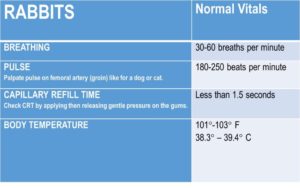 Males are called bucks. Females are does. Babies are kits or kittens. No matter what you call them, domesticated rabbits are truly indoor pets. They do not do well once temperatures reach 80°F. If you keep your bunny in an outdoor hutch, it must be well-protected from the elements and have a mister system, fan or other way to keep your bunny’s environment below that magic number or she may suffer hyperthermia.
Males are called bucks. Females are does. Babies are kits or kittens. No matter what you call them, domesticated rabbits are truly indoor pets. They do not do well once temperatures reach 80°F. If you keep your bunny in an outdoor hutch, it must be well-protected from the elements and have a mister system, fan or other way to keep your bunny’s environment below that magic number or she may suffer hyperthermia.
Rabbits can reproduce year round beginning at 5-8 months of age, so unless you are prepared to care for a houseful of bunnies for their lifetime (10-12 years), it is advisable to get males neutered and females spayed. Even if you don’t plan for your rabbit to be around another of the opposite sex, getting him or her “fixed” can keep him or her healthier and his or her attitude in check. Raging hormones can make a rabbit feisty to say the least!
Confer with your vet on your initial check-up as to whether it is the right time for this surgery. Although vaccinations are not required, you should take your pet rabbit to the vet annually to keep your little furry friend in the best of health and spot problems early.
On average, pet rabbits live 10-12 years, so owning a rabbit is a relatively long commitment but as well…a joy!
Before You Adopt
Please keep in mind that rabbits are prey animals. Almost everything goes after rabbits, so rabbits are inherently fearful. This includes children. Although a rabbit may seem like a good first pet, put yourself in a rabbit’s paws and realize how scary it might be for even the sweetest toddler to tower over the bunny chasing him around the house. Rabbits are precious friends that need supervision and TLC.
And for safety sake, remember that rabbit eyes are located on the sides of their head. Even if they eat a lot of carrots, their vision isn’t 20/20. It’s very important that you approach with your hand or food slightly from the side, so that the rabbit sees you coming. Try an experiment… make a fist with your left hand and hold it up to your own face between your eyes. Holding a carrot in your right hand, bring it towards your fist, straight at your face. This is similar to what a rabbit would see: nothing, until you move the carrot slightly to one side or the other.
Checking Vitals and Examining Your Bun From Nose to Fluffy Tail
Giving your bunny the once over by performing a weekly head-to-tail check-up can help you find a problem before it becomes a nightmare.
Not all rabbits enjoy being held, so your bun may feel more comfortable if you sit on the floor with her in front of you. It is key to go at a pace that is comfortable for her. Do this only when you are relaxed yourself, as animals always pick up on our stresses and besides finding health issues, this should be a good bonding time for you and your bun.
Starting at the ears, look inside to make sure nothing is red or infected and there is no presence of mites. Most rabbits enjoy a gentle scratch between the ears but never, ever pick up at rabbit by the ears!
Look at your rabbits eyes to make sure they aren’t tearing excessively and that they look bright and clear.
That twitching nose shouldn’t be runny or have any type of discharge. Since rabbits constantly wipe their faces, dirty paws can be the sign of a runny nose, so don’t forget to check as you work your way down your bunny.
It may take time for your rabbit to feel comfortable with you looking inside her mouth, but do your best to observe the gums making sure they are pink (unless they naturally have a darker pigment) and that the teeth seem to be wearing nicely. Rabbits have 28 continually growing teeth that can actually be quite sharp when puncturing human flesh, so do take care. Be sure your rabbit always has something to chew on to prevent malocclusion – a condition wear the teeth grow too long and won’t properly close resulting in the rabbit’s inability to properly chew her food. In addition to hay, apple & willow branches, toilet paper/paper towel rolls are good choices.
As you start to gently feel across her shoulders and down her back, combing out her coat might be in order. Rabbits undergo a heavy shed 3-4 times a year with lighter sheds in between. Sometimes it seems like rabbits shed year round! Long-haired breeds, such as Angoras, Lionheads and Jersey Woolies should be brushed daily to prevent matting.
Next rub your fingertips ever so carefully down each leg and check the pads of her feet looking for cuts, scrapes, lumps & bumps. Check those nails when you reach the paw pads and look between toes. Rabbit nails should be trimmed at least every 8 weeks. Ask your veterinarian to show you how. Short nails are less likely to get torn from catching in carpet or on their pen limiting her pain and your need to perform first aid.
Go on to feel your bunny’s abdomen. Her tummy should never feel hard or even like a water balloon which could alert you to G.I. Stasis, an emergency situation.
Continue to look your rabbit over, making sure there is no unusual discharge from the nipples or genitalia. Rabbits have scent glands on either side of their “privates.” These glands secrete a waxy substance which eventually hardens and can stick to your bun’s delicate skin, so if she is not taking care of this during grooming, be sure to clean her with a soft warm, wet cloth.
Urine scald can be painful, so check your rabbit regularly for this. When bunnies urinate, they push their hips back and lift their tail urinating away from their body. Sometimes however, the urine soaks the fur in the groin, and if a rabbit is arthritic or over-weight, she just may not be able to aim properly. Turning white fur yellow is the least problematic, the urine burns your rabbit’s skin. Check with your vet if Virbac Allercalm® or a similar shampoo would be best for regular “butt baths” and what calming cream (Zinc oxide, white Vaseline) he or should suggests. Urine scald can be caused by various urinary tract and other ailments, as well as unkempt litter boxes. A veterinary visit is in order if this happens more than once.
Male rabbits can develop testicular cancer even though unsprayed female rabbits tend to have a higher cancer rate. Feeling for unusual bumps and noticing anything that is not normal for your rabbit just might catch a problem early. There is nothing though like that annual veterinary visit to keep health issues at bay.
After you feel your way down your rabbits hips, back legs and paws (like you did the front legs) don’t forget to check the tail as well for lumps, bumps, discharge, fleas, cuts, scrapes or anything that shouldn’t be there.
By knowing what is normal for your rabbit, you can more quickly determine when something is not right and get her professional medical attention.
As you’re doing your Head-to-Tail Check, you can also check your rabbit’s vital signs. Refer to the chart below. Obtaining baseline numbers is important for understanding normal body functions during moments of rest, activity and anxiety.

To determine your rabbit’s respiration, watch the rise and fall of her chest to count breaths. One inhalation and one exhalation equals one breath.
You can feel the pulse by placing the tip of your middle finger in her groin area, feeling for the movement of blood through the femoral artery. It’s similar to feeling at your own wrist or neck but may take you a while to master.
Capillary refill time refers to gum color, which should generally be “bubble gum pink,” unless your rabbit has dark eyeliner and dark pigmented gums. To determine how long it takes for a capillary to refill, you will need to press firmly, but gently, on your rabbit’s gums (side of the mouth is preferred) just above the teeth. You’re squeezing “the straw” (aka tiny blood vessel) diminishing the blood flow. When you remove the pressure of your finger tip, the pink color should come back (or the darkened pigment) in 1.5 seconds or less meaning circulation is good and the blood and oxygen are flowing at a sufficient rate through the vessel. If it takes longer than 1.5 seconds however, you should quickly get your bunny to veterinary care.
To measure your rabbit’s body temperature, it is best to ask your veterinarian to properly show you how. Using a well lubricated digital thermometer, you’ll want to very carefully insert ½” into the anus to get the reading.
This chart can help you focus on normal averages for most buns. Hopefully your rabbit lies in the ranges indicated below, but discuss with your rabbit veterinarian if anything seems not quite right! Remember, every rabbit is a unique individual. What is normal for one, just may not be normal for another bunny.
Signs & symptoms that your rabbit needs immediate medical care:
- Hasn’t eaten in 24 hours
- I. Stasis
- Lethargic/unresponsive
- Temperature below 99° F or above 104° F
- Difficulty breathing/panting
- Rapid or non-existent pulse
- Seizures or head tilt
- Weakness or signs of paralysis
- Limb dangling or not moving
- Diarrhea, drooling or unusual discharge
- Bite wound that has broken the skin
- Uncontrolled bleeding (more than 5 mins)
- Straining while urinating
GET TO THE VET!
To learn more about care and first aid for your rabbit, check out my book, First Aid Basics for Rabbits and Pocket Pets and and the corresponding online certificate course!












